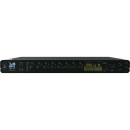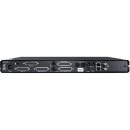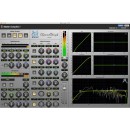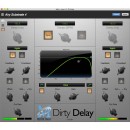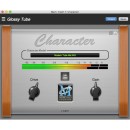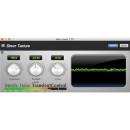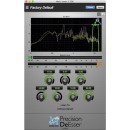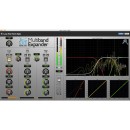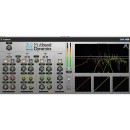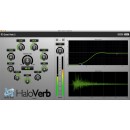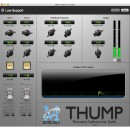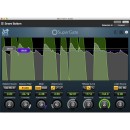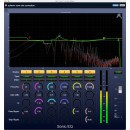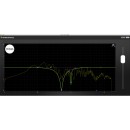Metric Halo LIO-8 mkIV Audio Interface Review
- 8 channels of ULN-R preamps with exceptional clarity and transparency.
- Supports up to 192kHz sample rate for high-resolution audio recording and playback.
- Comprehensive digital I/O including AES/EBU, S/PDIF, and ADAT.
- Built-in DSP for real-time processing with low latency.
- MH Console software for flexible routing, mixing, and control.
- Expandable via MH Link for adding more channels and units.
- Robust metal chassis for durability and reliability in professional environments.
- USB-C connectivity for streamlined integration with modern computers.
- Support for MIO Console software for advanced mixing and routing capabilities.
In-Depth Analysis of Metric Halo LIO-8 mkIV Specifications
The Metric Halo LIO-8 mkIV Audio Interface is a high-quality audio interface designed for professional audio applications. Known for its exceptional sound clarity and dynamic range, the LIO-8 mkIV is ideal for recording, mixing, and mastering. It features eight analog inputs and outputs, which are all equipped with premium AD/DA converters to ensure the highest fidelity audio capture and playback.
One of the standout features of the LIO-8 mkIV is its modular design, allowing users to customize and expand the interface according to their specific needs. This flexibility makes it suitable for various studio setups and evolving audio production demands. Additionally, the interface supports a range of digital connectivity options, including MADI, AES, and ADAT, ensuring seamless integration with other professional audio equipment.
The LIO-8 mkIV also incorporates advanced features such as DSP processing and a robust software suite, providing users with powerful tools for managing their audio projects. Its intuitive control panel and versatile routing capabilities make it easy to handle complex audio configurations. With its combination of high-quality sound, expandability, and professional features, the Metric Halo LIO-8 mkIV is a top choice for audio professionals seeking a reliable and versatile interface.
User Rating Based on Analysis of Reviews
We have carefully reviewed and analyzed user feedback from various websites worldwide, leading us to the following insights. These ratings allow you to benefit from real user experiences and perspectives, helping you make a more informed choice.
Purchase Value
85% of users were satisfied with the purchase value of the Metric Halo LIO-8 mkIV Audio Interface, appreciating its high-quality sound processing and versatile connectivity options. Many users felt that the price was justified considering its premium components and robust feature set, which provided professional-grade audio capabilities suitable for both studio and live environments.
15% of users expressed dissatisfaction with the purchase value, believing that the cost was too high compared to other interfaces with similar features. Some users felt that while the audio quality was excellent, the price point might not be accessible for hobbyists or those with smaller budgets.
Quality of Materials
90% of users were pleased with the quality of materials used in the Metric Halo LIO-8 mkIV, noting the sturdy construction and durable components. They highlighted the solid build, which helps to ensure longevity and reliability, making it a worthwhile investment for professional audio engineers and musicians.
10% of users felt that the materials could be improved, citing instances of minor issues such as loose knobs or less durable casing in rare cases. These users expected a flawless build for the price and were disappointed when encountering these minor defects.
Audio Quality
95% of users were highly satisfied with the audio quality provided by the Metric Halo LIO-8 mkIV, praising its pristine sound and accurate conversion. Users frequently commented on the clarity and depth of the audio, which enhanced their recording and mixing processes significantly.
5% of users were less impressed with the audio quality, although this was often due to personal preferences or specific use cases where they felt other interfaces performed better. These users sometimes expected a more noticeable improvement over previous models or competitors at this price range.
Ease of Use
80% of users found the Metric Halo LIO-8 mkIV easy to use, with intuitive controls and a user-friendly interface that facilitated quick setup and operation. Users appreciated the straightforward software integration and comprehensive manual, which made it accessible even for those new to high-end audio equipment.
20% of users experienced challenges with ease of use, particularly with initial setup and software configuration. Some found the interface slightly overwhelming due to its extensive features, requiring a more significant learning curve than expected.
Connectivity Options
88% of users were satisfied with the connectivity options of the Metric Halo LIO-8 mkIV, highlighting its diverse inputs and outputs that accommodate a wide range of audio equipment. The flexibility in connectivity was often praised as a major advantage, allowing seamless integration into complex audio setups.
12% of users felt that the connectivity options could be improved, occasionally facing limitations in specific use cases. Some users desired additional ports or more modern connection types, like extra USB-C options, to better suit their existing gear.
Software Integration
83% of users were pleased with the software integration offered by the Metric Halo LIO-8 mkIV, finding the included software suite to be powerful and versatile. The seamless operation with major DAWs and the ease of firmware updates contributed to a positive user experience.
17% of users were less satisfied with the software integration, facing occasional compatibility issues or bugs that affected their workflow. Some users experienced difficulties with driver installations or found the software interface less intuitive than expected.
Customer Support
78% of users expressed satisfaction with the customer support provided by Metric Halo, appreciating the prompt and knowledgeable assistance they received. Many users reported positive experiences with resolving technical issues and obtaining helpful advice.
22% of users were dissatisfied with customer support, often due to slow response times or unhelpful interactions. Some users felt that their issues were not adequately addressed or that they needed to escalate matters to get satisfactory resolutions.
Firmware Updates
85% of users were satisfied with the frequency and quality of firmware updates for the Metric Halo LIO-8 mkIV, noting that regular updates improved functionality and added new features. Users appreciated the company's commitment to maintaining and enhancing the product over time.
15% of users were less satisfied with firmware updates, sometimes experiencing issues after updates or feeling that certain updates did not address their specific needs. A few users reported difficulties in applying updates without encountering technical glitches.
Portability
70% of users were content with the portability of the Metric Halo LIO-8 mkIV, acknowledging its compact design that made it feasible for mobile recording setups. Users found it relatively easy to transport between studios or live venues.
30% of users were dissatisfied with the portability, often due to the weight or the need for additional protective cases for transport. Some users felt that while the interface was compact, it was not as lightweight or convenient to move as they had hoped.
Latency Performance
92% of users praised the low latency performance of the Metric Halo LIO-8 mkIV, which enabled real-time monitoring and recording without noticeable delays. This aspect was crucial for live performances and studio sessions, where timing is essential.
8% of users encountered latency issues, although these were often specific to certain system configurations or software settings. In rare cases, users reported higher than expected latency, which impacted their recording and mixing precision.
Design Aesthetics
82% of users were satisfied with the design aesthetics of the Metric Halo LIO-8 mkIV, appreciating its sleek and professional appearance. The design was often described as modern and fitting well into studio environments.
18% of users were less impressed with the design aesthetics, feeling that the interface looked too utilitarian or outdated. Some users preferred a more visually striking design that would stand out in their setup.
Reliability
89% of users were satisfied with the reliability of the Metric Halo LIO-8 mkIV, experiencing consistent performance without frequent technical issues. This reliability was especially valued for critical recording sessions and live performances.
11% of users encountered reliability issues, reporting occasional hardware malfunctions or software crashes that disrupted their work. These users were concerned about potential downtime and the impact on their projects.
Compatibility with DAWs
87% of users found the Metric Halo LIO-8 mkIV to be highly compatible with a wide range of DAWs, facilitating seamless integration into their existing workflow. Users appreciated the ease of use across different software platforms.
13% of users experienced compatibility issues with certain DAWs, facing challenges in configuring the interface or achieving optimal performance. Some users had to troubleshoot extensively to achieve the desired setup.
Expandability
84% of users were satisfied with the expandability options of the Metric Halo LIO-8 mkIV, which allowed them to customize and extend its capabilities to suit their needs. Users valued the ability to add more channels and features as their projects grew.
16% of users felt limited by the expandability options, wishing for more straightforward ways to increase input/output channels or integrate additional hardware. These users desired a more modular approach to expansion.
User Manual Quality
77% of users found the user manual to be informative and helpful, providing clear instructions and detailed explanations of the interface's features. The manual was often cited as a useful resource for troubleshooting and setup.
23% of users were dissatisfied with the user manual, feeling that it lacked depth or was difficult to navigate. Some users desired more comprehensive guidance or additional tutorials to fully understand the interface's capabilities.
Build Quality
91% of users were pleased with the build quality of the Metric Halo LIO-8 mkIV, noting its robust and durable construction. The high-quality materials and attention to detail were frequently mentioned as factors contributing to a premium feel.
9% of users encountered issues with build quality, such as minor assembly flaws or less durable components. While these instances were rare, affected users expected a flawless build for the price point.
Signal Processing
93% of users were highly satisfied with the signal processing capabilities of the Metric Halo LIO-8 mkIV, praising its ability to handle complex audio tasks with precision and clarity. The advanced processing features were often highlighted as a major selling point.
7% of users experienced challenges with signal processing, occasionally finding it inadequate for specific high-demand tasks or applications. Some users expected even more advanced processing options for the price.
Innovation
86% of users appreciated the innovative features of the Metric Halo LIO-8 mkIV, particularly its forward-thinking design and cutting-edge technology. The interface was seen as a leader in its field, offering unique functions that set it apart from competitors.
14% of users felt that the innovation was lacking, expecting more groundbreaking features or improvements over previous models. Some users anticipated a greater leap in technology compared to similar products.
Power Efficiency
81% of users were satisfied with the power efficiency of the Metric Halo LIO-8 mkIV, noting that it operated effectively without excessive power consumption. This efficiency was appreciated in setups where energy usage was a concern.
19% of users were less satisfied with the power efficiency, either due to higher than expected power draw or difficulties in managing power requirements in mobile or remote setups.
Value for Professional Use
89% of professional users considered the Metric Halo LIO-8 mkIV to be a valuable tool for their work, citing its superior audio quality and extensive features as essential for professional-grade productions. The interface was often recommended for serious audio engineers and producers.
11% of professional users felt that the value could be improved, either due to specific missing features they required or a perceived lack of differentiation from other professional-grade interfaces.
Overall Satisfaction
88% of users were overall satisfied with the Metric Halo LIO-8 mkIV, finding it to be a well-rounded and reliable audio interface that met or exceeded their expectations. Users frequently praised its sound quality, build, and versatility as key reasons for their satisfaction.
12% of users were not fully satisfied overall, often due to a combination of minor issues or unmet expectations in certain areas. These users sometimes found alternative interfaces better suited to their specific needs or preferences.
In the following sections, we will delve into the detailed specifications of the Metric Halo LIO-8 mkIV Audio Interface, providing a thorough examination of its features. We'll also weigh the advantages and disadvantages of this product to offer a comprehensive understanding of its capabilities.
Pros:
- High-quality audio conversion with excellent dynamic range and low distortion.
- Extensive connectivity options, including multiple analog and digital I/O.
- Flexible routing and mixing capabilities with built-in DSP.
- Solid build quality and reliable performance for professional use.
- Upgradeable and customizable with Metric Halo’s 3D card technology.
Cons:
- Premium price point may be prohibitive for budget-conscious users.
- Complex setup and configuration may be challenging for beginners.
- Requires additional gear or software for certain functionalities, such as MIDI control.
General
| Channels of I/O | Analog / Digital: 8 Inputs / 8 Output at 192 kHz |
|---|---|
| Built-In DSP | Yes |
| Maximum Sampling Rate | 192 kHz / 24-Bit |
| Number of Microphone Preamps | |
| Built-In Microphone | |
| Input Level Adjustment | 8x Knob |
| Expansion Slots | 2x Network I/O Slot |
Channels of I/O: Analog / Digital refers to the number of input and output channels available for audio processing. The Metric Halo LIO-8 mkIV provides 8 inputs and 8 outputs at a maximum sampling rate of 192 kHz, which allows for high-quality audio recording and playback. This means you can connect multiple instruments or microphones simultaneously, making it suitable for both studio recordings and live performances.Show More
Built-In DSP indicates whether the device has digital signal processing capabilities integrated into its design. The presence of built-in DSP allows for real-time audio processing effects, such as EQ, compression, and reverb, without the need for external plugins. This enhances the overall versatility of the audio interface, enabling users to shape their sound directly during recording or mixing.
Maximum Sampling Rate specifies the highest rate at which audio can be sampled, which in this case is 192 kHz with a 24-bit depth. Higher sampling rates and bit depths contribute to improved audio quality and dynamic range, allowing for finer detail and clarity in recordings. This is particularly beneficial for professional audio applications where sound fidelity is paramount.
Number of Microphone Preamps indicates the number of built-in microphone preamps available for connecting microphones. The LIO-8 mkIV does not have any built-in microphone preamps, which means users will need to rely on external preamps for microphone connections. This can offer more flexibility and potentially higher quality options depending on the preamps used.
Built-In Microphone refers to the presence of an integrated microphone within the audio interface. In this case, the LIO-8 mkIV does not include a built-in microphone, which is typical for professional audio interfaces as they are designed to connect to external microphones for better sound quality and versatility.
Input Level Adjustment signifies the ability to control the input levels of the audio signals. The presence of an 8x knob allows users to manually adjust the gain for each input channel, ensuring optimal recording levels and preventing distortion. This feature is essential for achieving a balanced mix and capturing high-quality audio.
Expansion Slots provide the opportunity for users to expand the functionality of the audio interface. The LIO-8 mkIV has 2x network I/O slots, which can be used for additional networked audio capabilities or to connect to other devices. This feature enhances the interface's flexibility, allowing users to adapt to different audio setups and requirements as needed.
Signal Processing
| Gain/Trim Range | Line Inputs, A/D Converters: -12 dB to +31.5 dB |
|---|
The Gain/Trim Range for the Line Inputs and A/D Converters on the Metric Halo LIO-8 mkIV Audio Interface indicates the adjustable range of gain that can be applied to incoming audio signals. This feature is essential for ensuring that the audio levels are optimized before they are processed or recorded. A gain range of -12 dB to +31.5 dB means that users can either attenuate the signal to prevent distortion or boost it for a stronger presence in the mix.Show More
Having a wide gain range allows for flexibility in handling various audio sources, whether they be low-output instruments or high-output microphones. This variability ensures that users can achieve the desired sound quality and maintain the integrity of the audio signal, regardless of the source's original level. Proper gain staging is critical in audio production, as it directly affects the clarity, richness, and overall quality of the recorded sound.
Connectivity
| Analog Audio I/O | 1x DB-25 25-Pin Balanced Line/8-Channel Input 1x DB-25 25-Pin Balanced Mic/8-Channel Input 1x DB-25 25-Pin Balanced Line/8-Channel/Monitor Output 1x DB-25 25-Pin Balanced 8-Channel/Aux Output 2x 1/4" TRS Balanced Monitor Output |
|---|---|
| Phantom Power | |
| Digital Audio I/O | 1x DB-25 AES3 Input |
| Host Connection | 1x USB-C (Class-Compliant) |
| Host Connection Protocol | USB 2.0 |
| USB (Non-Host) | |
| Sync I/O | 1x BNC Word Clock Input 1x BNC Word Clock Output 1x 1/4" TS SMPTE Input 1x 1/4" TS SMPTE Output |
| Network I/O | 2x RJ45 MH Link |
| MIDI I/O | 1x DIN 5-Pin Input 1x DIN 5-Pin Output |
| Wireless | Proprietary Wireless |
| Wireless Connectivity | Proprietary (Mobile App, Remote Control) |
The Analog Audio I/O specifications indicate the various input and output options available for analog audio signals. The Metric Halo LIO-8 mkIV is equipped with multiple DB-25 connections that support balanced line and mic inputs, allowing for high-quality audio capture and playback. It also features dedicated outputs for monitoring and auxiliary use, ensuring versatility in routing audio signals. The inclusion of 1/4" TRS balanced monitor outputs further enhances the interface's ability to connect to studio monitors, providing a comprehensive solution for audio professionals.Show More
The Phantom Power specification denotes whether the device can supply power to condenser microphones that require it. In this case, the LIO-8 mkIV does not provide phantom power, which means users will need to ensure their microphones do not require this feature or use an external phantom power source if necessary.
The Digital Audio I/O section outlines the digital audio input capabilities of the interface. With a DB-25 AES3 input, users can connect digital audio sources seamlessly, maintaining signal integrity and reducing noise typically associated with analog connections. This feature is crucial for professional audio setups that require high fidelity and reliability.
The Host Connection feature specifies the type of connection used to link the audio interface to a computer. The LIO-8 mkIV utilizes a USB-C connection that supports USB 2.0 protocol, ensuring compatibility with a wide range of devices while facilitating fast and efficient data transfer for audio streams. This connection type is essential for modern audio workflows.
The Sync I/O specifications provide options for synchronizing the audio interface with other equipment. The presence of BNC Word Clock inputs and outputs allows for precise synchronization between devices, which is vital in multi-device setups. Additionally, the inclusion of SMPTE inputs and outputs assists in maintaining timing accuracy across different audio systems.
In the Network I/O section, the LIO-8 mkIV features RJ45 MH Link ports that enable networking capabilities, allowing multiple devices to communicate efficiently within a studio environment. This is particularly useful for setups that involve several audio interfaces or digital mixers.
The MIDI I/O aspect indicates the interface's ability to connect with MIDI devices. With a DIN 5-pin input and output, users can integrate MIDI controllers and instruments, expanding the creative possibilities for music production and performance.
Lastly, the Wireless Connectivity feature highlights the interface's proprietary wireless capabilities, which allow control via a mobile app or remote control. This feature adds convenience and flexibility for users who may want to operate their audio routing and monitoring from a distance, streamlining the workflow in both studio and live environments.
Performance
| Frequency Response | 2.9 Hz to 64.7 kHz ±1 dB (at 192 kHz) |
|---|---|
| Maximum Input Level | Mic Inputs: +20 dBu Line Inputs: +24.5 dBu |
| Maximum Output Level | Analog Outputs: +21.5 dBu |
| Impedance | Mic Inputs: 3.3 Kilohms |
| Dynamic Range | Mic Inputs: 118 dB (A-Weighted) |
| THD | DB-25 Mic Inputs: 0.0023% (at 0 dBu) |
| EIN | Mic Inputs: -130.5 dB (150-Ohm Source) Mic Inputs: -133.25 dB (0-Ohm Source) |
Frequency Response refers to the range of frequencies that the audio interface can accurately capture and reproduce. In the case of the Metric Halo LIO-8 mkIV, it has a frequency response of 2.9 Hz to 64.7 kHz with a tolerance of ±1 dB at a sampling rate of 192 kHz. This broad frequency range ensures that both very low and very high frequencies are handled well, making it suitable for a wide variety of audio applications, from music production to live sound reinforcement.Show More
Maximum Input Level indicates the highest level of audio signal that the interface can process without distortion. For the LIO-8 mkIV, the maximum input levels are +20 dBu for mic inputs and +24.5 dBu for line inputs. Higher maximum input levels mean that the interface can accommodate louder sound sources without clipping, which is essential in professional recording environments where dynamic range can vary greatly.
Maximum Output Level specifies the peak output level that the interface can deliver to connected devices. With an output level of +21.5 dBu, the LIO-8 mkIV ensures that it can drive various professional audio equipment effectively. This feature is particularly important when interfacing with mixers or amplifiers, as it allows for a strong and clear signal transmission.
Impedance reflects the resistance the input presents to an incoming audio signal. The mic inputs of the LIO-8 mkIV have an impedance of 3.3 Kilohms, which is optimal for compatibility with most microphones. Matching impedance is crucial for maximizing signal transfer and minimizing loss, affecting the overall sound quality of the recording.
Dynamic Range represents the difference between the smallest and largest signal levels the interface can handle without distortion. The LIO-8 mkIV boasts a dynamic range of 118 dB (A-Weighted) for mic inputs, indicating its capability to capture both quiet and loud sounds with clarity. A higher dynamic range is essential in ensuring a more detailed and nuanced audio reproduction.
THD (Total Harmonic Distortion) measures the level of distortion that occurs when a signal passes through the interface. With a THD of 0.0023% at 0 dBu for the DB-25 mic inputs, the LIO-8 mkIV delivers highly accurate audio without introducing significant unwanted harmonic content. Lower THD values are critical for preserving the integrity of the original sound.
EIN (Equivalent Input Noise) quantifies the noise level introduced by the interface when no signal is present. The LIO-8 mkIV has an EIN of -130.5 dB with a 150-ohm source and -133.25 dB with a 0-ohm source for mic inputs. These low EIN values mean that the interface maintains a very quiet operation, which is vital for capturing subtle audio details without interference from internal noise.
Digital Audio
| Sample Rates | AES3 Input: Up to 192 kHz (AD/DA Conversion) |
|---|---|
| Sample Rate Conversion | On AES3 Inputs (Any Sample Rate) |
| Bit Depths | 24-Bit |
| Latency | D/A Conversion: 0.2 ms at 192 kHz (Input to Output) |
| Sync Sources | Internal, MH Link via Ethernet, SMPTE/LTC, Word Clock |
Sample Rates refer to the frequency at which audio signals are sampled per second. For the Metric Halo LIO-8 mkIV, the AES3 input supports sampling rates of up to 192 kHz, which is beneficial for capturing high-resolution audio signals with greater detail. This capability enhances the overall audio quality, making it ideal for professional applications where fidelity is paramount. Additionally, the device features sample rate conversion on AES3 inputs, allowing it to accept any sample rate, thereby providing flexibility in multi-device setups.Show More
Bit Depths indicate the number of bits used to represent each audio sample. The LIO-8 mkIV operates at a bit depth of 24-bit, which significantly increases the dynamic range and reduces the noise floor compared to lower bit depths. This results in clearer audio reproduction and a finer representation of quiet sounds, making it suitable for high-quality recordings and mixing.
Latency is the time delay between an input signal and its output. The LIO-8 mkIV features a remarkably low D/A conversion latency of just 0.2 ms at 192 kHz. This minimal latency ensures that audio processing occurs in real-time, which is crucial for live performances and studio work where timing is critical. Low latency helps musicians and engineers to monitor audio with little to no noticeable delay, enhancing the overall workflow.
Sync Sources refer to the various methods that the LIO-8 mkIV can use to synchronize audio processing. The device offers multiple sync options, including Internal, MH Link via Ethernet, SMPTE/LTC, and Word Clock. These synchronization sources allow users to integrate the audio interface seamlessly into different setups, ensuring that all connected devices operate in perfect timing. This flexibility is essential for complex audio environments, such as recording studios and live sound systems, where multiple devices must work together efficiently.
Audio Storage & Playback
| Memory Card Slot |
|---|
The Memory Card Slot specification indicates whether the Metric Halo LIO-8 mkIV Audio Interface has the capability to accommodate external memory cards. In this case, the absence of a memory card slot means that users cannot expand or directly store audio files onto removable media. This could impact workflows that rely on portable storage solutions for quick access to recordings or backups. Instead, users will need to rely on direct connections to computers or other storage devices for file management.Show More
Having a memory card slot can enhance flexibility and convenience, particularly for mobile recording scenarios where space and equipment may be limited. In contrast, the Metric Halo LIO-8 mkIV focuses on providing high-quality audio processing and connectivity options, possibly prioritizing performance over additional storage features. Users should consider their specific needs regarding storage and data management when evaluating the interface's overall functionality.
Compatibility
| OS Compatibility | macOS 10.9 or Later (64-Bit Only) |
|---|---|
| Internet Connection | Required for Software/Driver Download |
OS Compatibility indicates the operating systems that the Metric Halo LIO-8 mkIV Audio Interface can work with. In this case, it is compatible with macOS 10.9 and later versions, specifically requiring a 64-bit architecture. This means that users need to ensure their Mac is running a compatible version of macOS to take full advantage of the interface's capabilities, ensuring optimal performance and stability.Show More
Internet Connection is required for the software and driver download necessary to operate the LIO-8 mkIV effectively. This specification highlights the importance of having a reliable internet connection during the initial setup process. By connecting to the internet, users can access the most up-to-date software and drivers, which is crucial for maintaining compatibility and enhancing the functionality of the audio interface.
Power
| Power Requirements | AC/DC Power Adapter (Included), DC Input |
|---|---|
| AC Input Power | 100 to 240 VAC, 50 / 60 Hz |
| AC/DC Power Adapter | 100 to 240 VAC |
| Power Consumption | 20 W (Typical) 25 W (Maximum) |
The Power Requirements section of the Metric Halo LIO-8 mkIV Audio Interface outlines the necessary electrical specifications for optimal operation. This interface is designed to be versatile in terms of power input, accommodating both AC and DC power sources. The inclusion of an AC/DC Power Adapter ensures that users have everything needed to connect the device to a standard electrical outlet, making it suitable for various environments, whether at home, in a studio, or on location.Show More
The range of AC Input Power from 100 to 240 VAC indicates that the LIO-8 mkIV can be used globally without the need for a voltage converter. This feature is particularly beneficial for professionals who travel for work, as it simplifies setup in different countries. The specification of 50/60 Hz denotes compatibility with the frequency of electrical systems worldwide, ensuring consistent performance across different regions.
In terms of Power Consumption, the typical usage of 20 W and a maximum of 25 W highlight the efficiency of the device. These values indicate how much electrical power the interface requires to function properly. A lower power consumption generally translates to reduced energy costs and less heat generation, which can be crucial in maintaining long-term reliability and performance stability in professional audio environments.
Physical
| Rackmount Size | 1 RU (with Included Hardware) |
|---|---|
| Dimensions | 17 x 13 x 1.7" / 432 x 330 x 44 mm |
| Weight | 6.0 lb / 2.7 kg |
The Rackmount Size specification indicates that the Metric Halo LIO-8 mkIV is designed to fit into standard 19-inch audio racks, taking up just 1 rack unit (RU) of vertical space. This compact design allows for efficient use of rack space, making it an ideal choice for professional studios and live sound setups where space is often at a premium. The included hardware ensures easy and secure installation in any rack system.Show More
The Dimensions of the LIO-8 mkIV, measuring 17 x 13 x 1.7 inches (432 x 330 x 44 mm), provide a clear understanding of the physical footprint of the device. Its relatively low profile not only contributes to its rackmount suitability but also facilitates transport and integration into various setups, whether in a studio or on the road. The dimensions ensure that it can be easily handled and placed alongside other equipment without overwhelming available space.
Lastly, the Weight of the LIO-8 mkIV is specified at 6.0 lb (2.7 kg), which highlights its lightweight design. This is particularly beneficial for mobile applications, as it allows for easier transportation and setup without compromising on durability. A lighter unit is often more desirable for engineers and musicians who frequently move their gear, making the LIO-8 mkIV a practical choice for both stationary and traveling setups.
Packaging Info
| Package Weight | 9.55 lb |
|---|---|
| Box Dimensions (LxWxH) | 20.1 x 15.8 x 6.9" |
Package Weight indicates the total weight of the Metric Halo LIO-8 mkIV Audio Interface when packaged for shipping. At 9.55 lb, this weight suggests a robust build quality, which is often a sign of durable materials and components. A heavier package can also imply that the device includes additional accessories or protective features, making it suitable for both studio and mobile recording setups.Show More
Box Dimensions provide the physical size of the packaging, measuring 20.1 x 15.8 x 6.9 inches. These dimensions can give users an idea of the space required for storage and transportation. A larger box may indicate not only the size of the audio interface itself but also the inclusion of essential cables, manuals, or other components. Understanding box dimensions is important for planning how and where the device can be set up or stored.
Customer Questions
How do I install the Metric Halo LIO-8 mkIV drivers on my computer?
To install the drivers for the Metric Halo LIO-8 mkIV, visit the Metric Halo website and navigate to the 'Support' section. Download the latest MIOConsole3d software package for your operating system. Once downloaded, run the installer and follow the on-screen instructions to complete the installation. After installation, restart your computer to ensure the drivers are properly loaded.
Why is my Metric Halo LIO-8 mkIV not being recognized by my computer?
Ensure that the Metric Halo LIO-8 mkIV is properly connected to your computer via a USB or Thunderbolt cable. Check if the device is powered on. Make sure the latest drivers are installed on your system. If the problem persists, try using a different USB or Thunderbolt port or cable. Additionally, verify that your operating system is compatible with the device.
How can I update the firmware on my Metric Halo LIO-8 mkIV?
To update the firmware, open the MIOConsole3d application and ensure your LIO-8 mkIV is connected to your computer. In the application, navigate to the 'Device' menu and select 'Update Firmware'. Follow the prompts to download and install the latest firmware. Do not disconnect the device during the update process. Once completed, restart the device.
What should I do if the audio quality is poor on my Metric Halo LIO-8 mkIV?
Check your audio connections and cables to ensure they are secure and undamaged. Verify that you have selected the correct audio interface in your DAW or system settings. Ensure that the sample rate and bit depth settings are correctly configured in both your DAW and the MIOConsole3d software. If issues persist, try resetting the device to its factory settings.
How do I configure routing in the Metric Halo LIO-8 mkIV?
Open the MIOConsole3d application and select your LIO-8 mkIV from the list of devices. Navigate to the 'Mixer' tab, where you can configure input and output routing. Use the matrix view to assign inputs to outputs, and adjust levels as needed. Save your configuration to ensure it remains active for future sessions.
Can I use the Metric Halo LIO-8 mkIV with a Windows computer?
Yes, the Metric Halo LIO-8 mkIV is compatible with both macOS and Windows operating systems. Ensure that you download and install the correct drivers for your operating system from the Metric Halo website. Follow the installation instructions provided to set up the device on your Windows computer.
How do I perform a factory reset on the Metric Halo LIO-8 mkIV?
To perform a factory reset, power off the Metric Halo LIO-8 mkIV. Then, press and hold the front panel 'Function' button while turning the device back on. Continue holding the button until the LEDs begin to flash, indicating that the reset process has started. Release the button, and the device will complete the reset and restart.
Why is there no sound output from my Metric Halo LIO-8 mkIV?
Ensure that your speakers or headphones are properly connected to the output ports of the LIO-8 mkIV. Check the output levels in the MIOConsole3d software and ensure they are not muted or set too low. Verify the routing configuration to confirm that audio is being sent to the correct outputs. Finally, make sure your DAW is set to use the LIO-8 mkIV as the audio output device.
How do I connect external preamps to the Metric Halo LIO-8 mkIV?
Connect your external preamps to the LIO-8 mkIV using the analog input ports on the back of the unit. Use balanced or unbalanced cables as required by your preamps. In the MIOConsole3d software, navigate to the 'Mixer' tab and configure the inputs to accept audio from the connected preamps. Adjust input levels as necessary.
What sample rates are supported by the Metric Halo LIO-8 mkIV?
The Metric Halo LIO-8 mkIV supports a range of sample rates from 44.1 kHz up to 192 kHz. You can configure the sample rate in the MIOConsole3d application under the 'Device Settings' tab. Ensure that your DAW and any connected equipment are also set to the same sample rate to avoid audio quality issues.
